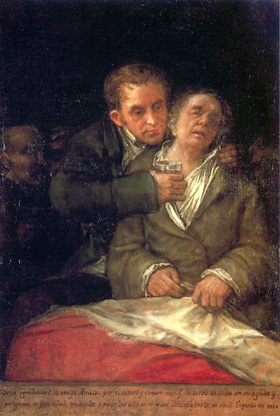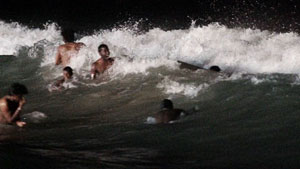Witness to a Massacre
John Haberin New York City
Enzo Camacho, Ami Lien, and Sohrab Hura
Marco Brambilla and Political Art
Enzo Camacho and Ami Lien bear witness to a massacre, but they leave the testimony to others who survived. They bear witness, too, to an Asian people's ways of life.
The massacre took place nearly forty years ago in Escalante, an island in the Philippines, but for Camacho and Lien it could just as well be today. For Sohrab Hura, also at MoMA PS1, India and its lives are barely hanging on. They are the Ghosts in My Sleep, in dreams filled with ghosts. Could they overwhelm the United States as well?  Thanks to the Web, AI, and his own video art, Marco Brambilla sees the massacre as having already begun.
Thanks to the Web, AI, and his own video art, Marco Brambilla sees the massacre as having already begun.
They have me thinking about political art and whether, even for a progressive artist, a message of any kind risks conservatism in art. Can form and content be at odds like that, and does it matter? Surely these artists hit home because their form and message alike aim for the eye and strike home to the gut. Before I say more about them, then, let me talk through the dilemma and the promise. I did so many years ago with one of this Web site's first essays, about an artist as in command of silence as Jan Vermeer—and yet even his women seem just about to speak. What would they say about art now?
The Limits of Political Art
Just to ask about such matters could serve as a frame for any discussion of political art. Not only political artists will feel strongly about it. So many, in every genre and medium, will speak of finding something more in what they do than a message. I would be wrong to write this off as formalism or, conversely, an overriding need for self-expression. A generation of late modern artists and postmodern critics dismissed all that came before as likely both, even as much of the public dismissed abstraction, conceptual art, and the present. We were not going to be like that, because we were not going to give up on art.
Still, it is only fair to insist that not just political art, but most art, maybe all art, has a subtext not to be dismissed. How often art that had seemed remote to me became vivid once I read more about it. I had not appreciated the depth and shimmer of oil colors in Jan van Eyck and the Northern Renaissance until art historians like Erwin Panofsky taught me their iconography, the stories they set out to tell. It was important not just, as artists themselves might suggest, because it caused me to look longer—long enough to start to see. Without it, the liquid darkness in Francisco de Goya and Disasters of War might have seemed a pale excuse for monochrome abstraction. With it, that darkness became a reason to look and a reason to paint.
Consider an artist whose politics extends well beyond her art. In All the Beauty and the Bloodshed, the film about Nan Goldin, a three-part narrative advances along parallel tracks throughout. The very first sequence speaks of the suicide of her sister, and the story continues to ground her work in her life with all its pain and triumph. The second track takes up her major work, the slideshow The Ballad of Sexual Dependency, in all its closeness to her but also its silence. These are her friends and loved ones in the age of AIDS, and one can only guess who in a photo is dying or a survivor. One can only guess, too, which of the couples sharing a frame can overcome their physical and emotional distance.
The third track ups the ante on both those narratives, her life and her life's work. It shows her as an activist backed by a movement. Their assault on the pharmaceutical industry advances, obliging museums to refuse tainted funding. And yet this last track will never fully engage a world outside of art institutions, and it all but gives up on art. Can political art, then, still make a difference? Did it ever?
As an undergraduate, a friend told me, he sought an answer in a hole in the ground. Joel Shapiro, the sculptor, asked his students for two works apiece, one sincere and one false, but forget that. For each, my friend dug much the same two holes in the program's yard, three by three by three. He started with the false one, but by the time he had turned up all that soil the false had become true. He might have felt a personal obligation or a personal violation in filling them up again.
At art's most rewarding, the artist's ideology is part of the work, too, intended or not. Whether politics, religion, or belief in itself, it develops right along with the visual and material. I think of existence and subtext as a bit like music and lyrics, and there is no point in making songs into lesser symphonies. The subtext can be what gets the artist up in the morning, throwing paint at canvas, or to bed in the evening, contemplating every detail, and it can raise other subtexts as well, like as the artist's disturbing passions. It is a writer's job to tease all these out and to show that form and content are alike part of the work, the very same work, and just what that entails. What goes wrong with bad political art may be that they never really are.
Patrimony and preservation
It sounds modest enough, as "Offerings for Escalante," and it becomes more poignant the more Enzo Camacho and Ami Lien listen. On film, newly commissioned, survivors speak of falling to the ground to avoid the bullets, only to find themselves lying among the dead. They do not so much as speak of what brought them together —a mass protest in 1985 against the Marcos regime. Nor do they mention the peaceful revolution that succeeded in deposing him a year later. It is enough to bear witness. Are they stronger for having come together and survived—or that much more helpless in remembering? They themselves may not know.
For Camacho and Lien, it is nonetheless a teachable moment. They convert the two-level gallery just outside the rest of the exhibition into a study hall. A second film, of the protest itself, projects on a huge wall like a banner. Posters, display cases, and monitors round out the class. The survivors also do not mention the cause that brought about the protest, a National Rural Employment Guarantee Act, itself a matter of survival. The artists leave nothing unstated.
They see a reminder of not just present-day inequality, but also a colonial history of sugar plantations and exploitation. They add assemblages of whatever grows, some centered on skulls and other reminders of death. They are more moving, though, in their new-found modesty. Between the testimonies comes silence, over light brown fragments of rags or film itself, like a torn trailer. More poignant still is testimony from those who did not have to face death, small children. They sing together, as in a playground or classroom, but the words speak again of death.
Sohrab Hura is all the more moving for never losing his innocence. At past forty, he is the elder statesman this time out at MoMA PS1 (which also exhibits artists in residence from the Studio Museum in Harlem). Jasmine Gregory joins in, too, with paintings after luxury watch ads, as "Who Wants to Die for Glamour." Gregory wants to remind you of patrimony, preservation, and all that you are missing. Apparently, it is never to late to learn. Hura does better with less certainty.
He started as a photographer, capturing individuals against a background of forlorn beaches and unpaved roads. Neither the photographer or his subjects seem able to strike a pose. Street photography is often short of composed, as in "We Are Here" at the International Center of Photography, and uncomposed photographs often fall flat. Here they seem about right, a bit like Instagram for Stephen Shore. Less happily, Hura has switched to pastel and gouache for Ghosts in My Sleep and Things Felt But Not Quite Expressed. Suffice it to say that he has something to say about his aging mother and her dog. Now if only he could express it.
He has, though, explored India and its lives more fully in photographs and film. It takes him to the north, for winter and a touch of snow. It takes him to a festival, with a carnival in slow motion, at once colorful and somehow sad. People come for the rides, but even more to immerse themselves in India's rough coastal waters, a Hindu ritual of renewal. There is joy in their splashing around, neither able nor caring to swim.
There are limits
Remember when America was on the verge of civil war, with right-wing armies ready to take their country back? Unfortunately, Donald J. Trump won the election, so no one will ever know, but fighting in the street rages on. You could call it a revolution in video. Only this time the marching, charging feet, boy, belong almost entirely to the police. Right on the way in at the gallery, a small screen barely contains the damage.  And that screen is only a trailer for an exploration of the medium to come.
And that screen is only a trailer for an exploration of the medium to come.
Then again, that may be why things are out of control: police themselves are breaking the law. For Marco Brambilla, they are the ones setting the fires and striking the blows. Something like it, I could argue, has happened on actual city streets. Had law enforcement done its job rather than raged at peaceful protests in favor of Black Lives Matter, maybe there would have been fewer lootings and more justice. And still, Brambilla knows, there are limits to control.
Already the short video had me afraid. It is not just the cuts back and forth between police geared for action and strangely quiet streets. It is also the cuts to a silhouette in fiery colors—of a man launching by hand a flare or grenade. In this context, the title screen looks more disturbing than the ocean in sunlight might otherwise suggest. Its ripples and crests are disturbance enough themselves, like a fire about to spread. Given the video loop, I hesitate to call it a beginning or an end.
The main event takes place behind a black curtain, on a doubly wide screen. Side by side, its two channels both reinforce and disrupt the video collage. This is Limit of Control, in the singular, but the efforts at control continue to multiply, and so do their limits. Not all of it takes place all that obviously on TV, although the talking heads include (repeatedly) Bill Clinton. Not all of it is made for TV either, although it has its costume drama. All of it, though, is found footage.
Brambilla relied on AI to collect the clips, although I might call it searching the Web. And that, too, leads to limits of control. Ever wonder what would have happened had the past unfolded in a 24/7 news cycle like today, with social media waiting to amplify every disagreement? Would the United States still have turned Jews away at the start of World War II? But then are mass killings any less likely today? Artists look less and less like masters of the created universe themselves.
Limit of Control has its own limits. It comes in a sometimes overwrought tradition of new media as theater, going back to Bill Viola. (The older artist happens to have a new video on the Lower East Side, too. People enter in Viola's characteristic slow motion, just in time to be swept away by titanic waters.) What exactly is Brambilla saying? Is he questioning a world filtered through TV or celebrating it? Or could theater, too, be a metaphor for inhuman control and perpetual war?

Enzo Camacho, Ami Lien, and Sohrab Hura ran at MoMA PS1 through February 17, 2025, Marco Brambilla at Bitforms through January 11. Bill Viola ran at James Cohan through December 21, 2024.




